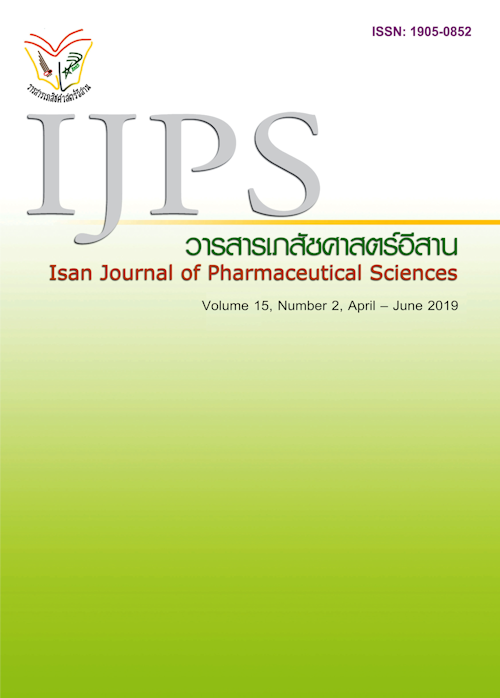Safety of out-of-season longan consumption
Main Article Content
Abstract
Introduction: Nowadays, out-of-season longan production in Thailand was generally stimulated by potassium chlorate. As the chemical is prohibited in food, this study was aimed to assess the health risk from consumption of these longan fruits. Materials and Methodology: Three different doses of potassium chlorate were applied on longan trees via root (each dose, n=5), and a control group (n=2). After 210 days of application, the longan fruits samples (ready-to-eat fruits) were collected. After extraction with water, the extracts reacted with indigo carmine and 6M HCl were analyzed for chlorate residues using UV-Spectrophotometer at 610 nm. Then, assessment of the health risk by Margin of Safety (MOS) was performed. Results: The highest concentration of chlorate residues in longan fruits was found in group 3 (960 g potassium chlorate/tree) at 0.2254±0.0004 µg/g and the lowest concentration was in control group at 0.0326±0.0001 µg/g. The risk assessment found that consumption of 10 fruits/day, 500 and 1,000 g/day of all treated fruits were safe as Margins of Safety were all higher than 1. Therefore, no adverse effects on health should be worried from consumption of out-of-season longan fruits in general population.
Article Details
In the case that some parts are used by others The author must Confirm that obtaining permission to use some of the original authors. And must attach evidence That the permission has been included
References
Surapol Thongtaing, 2009. The report of promotion out of season longan production in Chomtong District, Chaing Mai. Office of Agricultural Research and Development Region 1, Department of Agriculture, Chaing Mai, Thailand.
JML Safety Data Sheet, 2002. Potassium chlorate [Online]. Available: https://www.jmloveridge.com/cosh/Potassium%20Chlorate.pdf
Potassium chlorate, n.d. Potassium and advantages [Online]. Available from www.siamchemi.com/โพแทสเซียม/
Bernardo EO, Matos RI, Dawood T, Whiteway SL, 2015. Maternal Cautopyreiophagia as a Rare Cause of Neonatal Hemolysis.” A Case Report. 135(3):8–13.
Chiswell B and Keller-Lehmann B, 1993. Spectrophotometric Method for the determination of Chlorite and Chlorate, Analyst, Volume 118: page 1457-1459.
Mari Asami, Nobue Yoshida, Koji Kosaka, Koichi Ohno, Yoshihiko Matsui, 2003. Contribution of tap water to chlorate and perchlorate intake: A market basket study. Science of the Total Environment p.463–464, 199–208, citing MHLW (in Japanese) Available:https://www.mhlw.go.jp/topics/bukyoku/kenkou/suido/kijun/dl/ moku11.pdf
Environmental Protection Agency (US.EPA), 2017. Risk assessment for other effects [Online]. Available: https://www.epa.gov/fera/risk-assessment-other-effects
Thurlow JS, Little DJ, Baker TP, Yuan CM, 2013. Possible potassium chlorate nephrotoxicity associated with chronic matchstick ingestion. Clin Kidney J.6(3):316–8.
Soradech Chantiang, 2013. Chlorate residue in soil and agricultural economy compensation of potassium chlorate in longan plantation. Mae Joe University, Chaing Mai, Thailand
Srikanjana Klayraung, Tapana Cheunbarn, Piyanuch Niamsap, Narin Wongkhattiya, 2012. Chlorate reductase by bacteria reduced chlorate extracted from soil and waste water sludge. Mae Joe University, Chaing Mai, Thailand.

